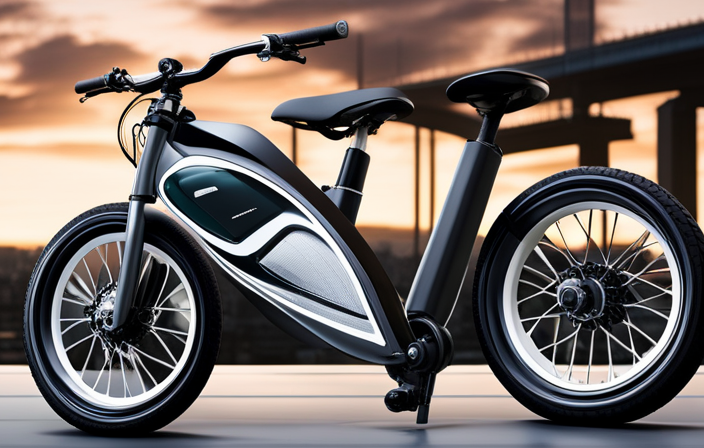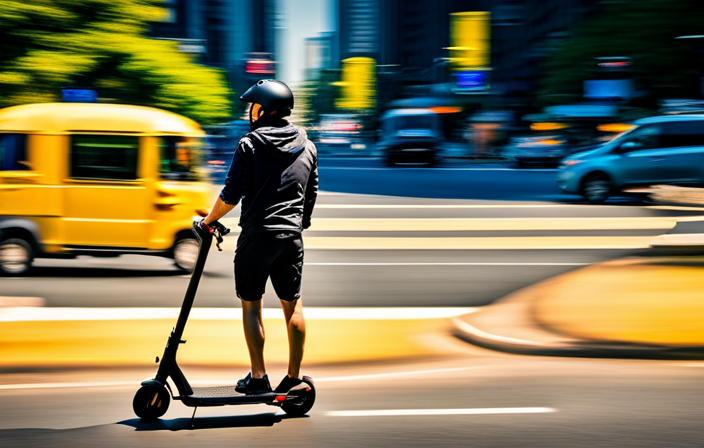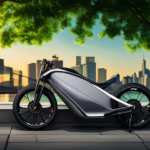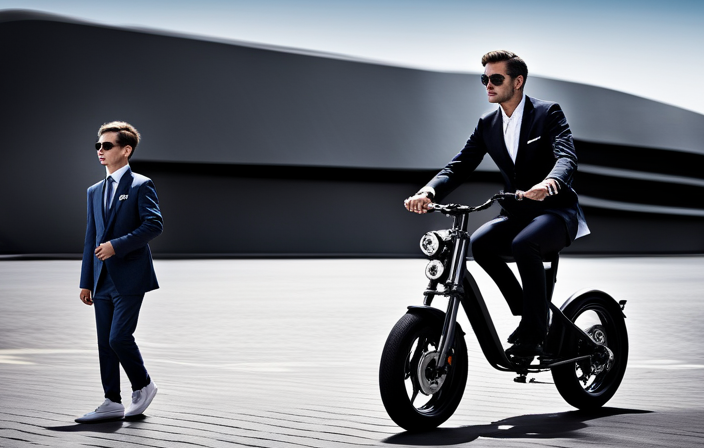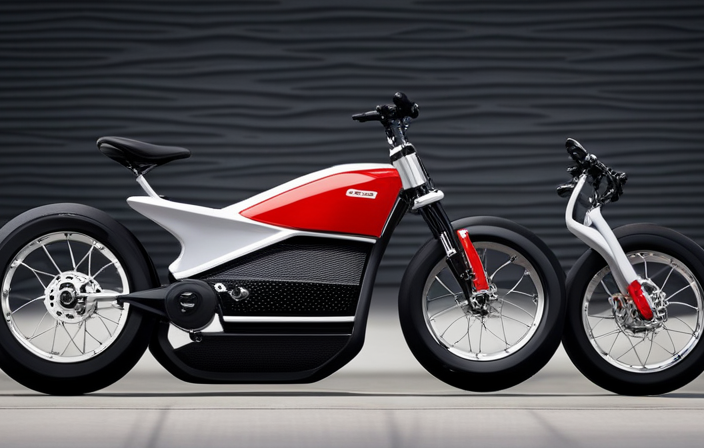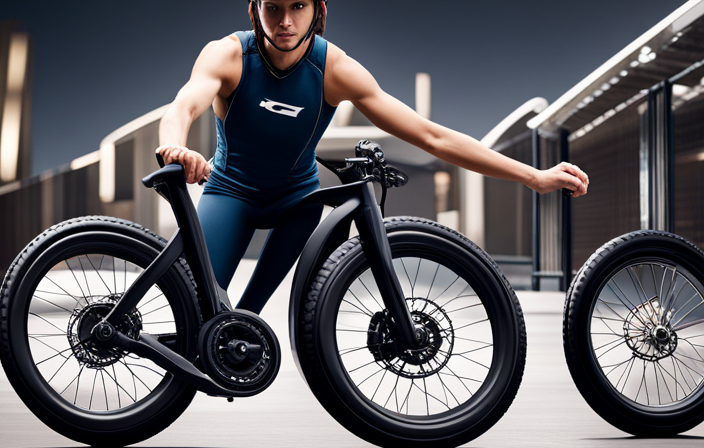I have always been intrigued by the inner mechanisms of electric bicycles, particularly the charging process. Exploring how electric bike charging operates on board is like discovering a secret realm of technology and effectiveness.
In this article, we’ll delve into the intricacies of this process, exploring different methods and even considering the future of this exciting technology. Whether you’re a seasoned electric bike enthusiast or just starting out, join me as we unravel the mysteries of on-board electric bike charging.
Key Takeaways
- On-board electric bike charging involves components such as a charger, battery management system (BMS), and charging port.
- Efficient charging ensures optimized battery replenishment during rides, extended riding range, convenience, and reduced reliance on external power sources.
- Solar-powered charging offers sustainability, cost savings, and reduced carbon footprint, although charging efficiency may be affected by weather conditions.
- Advancements in technology include improvements in battery technology, compact charging infrastructure, smart charging technologies, and integration with renewable energy sources.
Understanding the Basics of Electric Bike Charging
To understand the basics of electric bike charging, you’ll need to familiarize yourself with how the on-board charging system works. In electric bike battery technology, the on-board charging system consists of a charger, a battery management system (BMS), and a charging port.
The charger is responsible for converting AC power from the electrical outlet into DC power that can be stored in the battery. The BMS monitors the battery’s voltage, temperature, and current to ensure safe and efficient charging. It also protects the battery from overcharging and overheating. The charging port is where you connect the charger to the electric bike.
Optimizing charging efficiency is crucial for maximizing the range and lifespan of your electric bike battery. One way to do this is by charging your battery at the recommended voltage and current levels specified by the manufacturer. Charging at a higher voltage or current can lead to faster charging but may also degrade the battery faster. It is also important to avoid charging the battery in extreme temperatures, as this can affect its performance and lifespan.
Understanding the basics of electric bike charging sets the foundation for exploring the benefits of on-board electric bike charging. By optimizing the charging process, you can ensure that your electric bike is always ready for your next ride, while also prolonging the life of your battery.
The Benefits of On-Board Electric Bike Charging
One of the advantages of on-board e-bike charging is that it allows riders to conveniently recharge their batteries while they ride. This innovative technology offers several benefits to electric bike users, making it a popular choice among cyclists.
| Benefits of On-Board Electric Bike Charging | Description |
|---|---|
| Efficient Charging | On-board charging systems ensure efficient and optimized charging of e-bike batteries. Riders can replenish their battery power during their journey, eliminating the need for frequent stops to recharge. |
| Extended Riding Range | With on-board charging, riders can extend their riding range significantly. By charging the battery while riding, they can cover longer distances without worrying about running out of power. |
| Convenience and Flexibility | On-board charging provides riders with the convenience of charging their batteries on the go. It eliminates the hassle of finding charging stations or carrying spare batteries, giving cyclists the freedom to explore without limitations. |
| Environmental Friendliness | On-board charging promotes sustainability by reducing the reliance on external power sources. Riders can utilize renewable energy sources, such as regenerative braking, to charge their batteries, thus reducing their carbon footprint. |
| Enhanced Riding Experience | On-board charging enhances the overall riding experience by offering continuous and uninterrupted power supply. Cyclists can enjoy a smooth and consistent ride without worrying about battery depletion. |
These benefits highlight the advantages of on-board electric bike charging, making it a game-changer in the world of e-bikes. By incorporating this technology, riders can enjoy efficient charging, extended riding ranges, convenience, environmental friendliness, and an enhanced riding experience. Now, let’s explore how on-board electric bike charging works.
How Does On-Board Electric Bike Charging Work?
The way on-board e-bike charging functions is by allowing riders to replenish their battery power while they ride. This innovative technology has revolutionized the electric bike industry, providing convenience and efficiency for riders.
Here is a breakdown of how on-board electric bike charging works:
-
Electric bike charging infrastructure: To enable on-board charging, electric bikes are equipped with a charging port and a battery that can be recharged while in use. This eliminates the need for external charging stations and allows riders to charge their bikes on the go.
-
Advancements in charging technology: With advancements in charging technology, on-board electric bike charging has become more efficient and faster. Intelligent charging systems ensure that the battery is charged optimally, preventing overcharging and extending the battery’s lifespan.
-
Seamless integration: On-board charging systems seamlessly integrate with the bike’s powertrain, allowing riders to generate electricity through regenerative braking or pedaling. This means that every time the brakes are applied or the pedals are turned, energy is converted and stored in the battery.
Exploring different methods of on-board electric bike charging, we can see how technology has evolved to make charging more convenient and accessible for riders.
Exploring Different Methods of On-Board Electric Bike Charging
As we delve into the various methods of on-board e-bike charging, it’s clear that technology has greatly enhanced the convenience and accessibility of recharging for riders. One of the methods that has gained popularity is solar-powered charging. By harnessing the power of the sun, riders can charge their electric bikes while on the go, without relying solely on traditional charging methods.
Solar-powered charging offers several benefits, including sustainability and cost savings. It allows riders to tap into a renewable energy source, reducing their carbon footprint and contributing to a greener environment. Additionally, with solar-powered charging, riders can save money on electricity bills, as they are not solely dependent on grid power.
However, it is important to note that solar-powered charging does have its limitations. It relies on the availability of sunlight, meaning that charging may not be as efficient on cloudy or rainy days. Furthermore, the size and efficiency of the solar panels can impact the charging speed. Therefore, riders may need to plan their routes accordingly, ensuring they have enough sunlight exposure to recharge their bikes.
Transitioning into the subsequent section about solar-powered charging systems for electric bikes, it’s important to note that these systems provide a sustainable and efficient charging solution for riders.
Solar-Powered Charging Systems for Electric Bikes
By harnessing solar power, riders can conveniently recharge their e-bikes on the go, reducing their reliance on traditional charging methods. Here is a breakdown of how solar-powered charging systems for electric bikes work:
-
Solar Panel Efficiency: Solar panels are made up of photovoltaic cells that convert sunlight into electricity. The efficiency of these panels determines how much energy can be generated from the available sunlight. Advancements in solar panel technology have led to higher efficiency rates, allowing for more power generation even in low light conditions.
-
Cost Effectiveness of Solar Charging: Solar-powered charging systems can be a cost-effective solution for e-bike riders. Once installed, solar panels require minimal maintenance and have a lifespan of around 25 years. The initial investment may be higher, but the long-term savings on electricity bills make it a worthwhile investment.
-
Charging On the Go: Solar panels integrated into the e-bike’s frame or attached as an accessory can harness sunlight while riding. This allows riders to continuously charge their e-bike batteries during their journey, extending the range of their ride.
-
Battery Storage: To maximize the benefits of solar charging, e-bikes can be equipped with efficient battery storage systems. These systems store excess energy generated by the solar panels, ensuring a continuous power supply even when sunlight is not available.
With solar-powered charging systems, riders can enjoy the convenience of on-the-go charging while reducing their carbon footprint. Transitioning to the next section about regenerative braking and charging for electric bikes, let’s explore another innovative way to charge e-bike batteries.
Regenerative Braking and Charging for Electric Bikes
To maximize the efficiency of your e-bike’s battery, you can take advantage of regenerative braking. This feature converts the kinetic energy produced when you brake into electricity to recharge the battery. Regenerative braking is commonly found in electric bikes and allows for a more efficient use of the battery’s energy storage capacity.
When you apply the brakes on your e-bike, the system automatically switches to regenerative mode. In this mode, the motor acts as a generator, converting the energy from the motion of the wheels into electrical energy. This electrical energy is then stored in the battery for later use.
By utilizing regenerative braking, you can increase the overall efficiency of your electric bike. It allows you to recover energy that would otherwise be lost as heat during braking. This means you can ride for longer distances on a single charge and reduce the frequency of recharging your battery. Additionally, regenerative braking helps extend the lifespan of your battery by reducing the strain on it.
Transitioning into the subsequent section about using pedal power to charge your electric bike, you can also harness the power of your own energy to further extend the battery life of your e-bike.
Using Pedal Power to Charge Your Electric Bike
After exploring the concept of regenerative braking and charging, let’s now delve into an alternative method of charging an electric bike: pedal power.
Pedal powered charging offers an efficient and eco-friendly solution for extending the range of electric bikes.
Pedal powered charging systems consist of a generator connected to the bike’s drivetrain, which converts mechanical energy from pedaling into electrical energy. This electrical energy is then stored in the bike’s battery for later use. These systems are designed to provide a seamless charging experience without compromising the riding experience.
The efficiency of pedal powered charging depends on various factors such as the gear ratio, pedaling cadence, and the generator’s efficiency. Higher gear ratios allow for more revolutions per pedal stroke, resulting in increased electrical output. Similarly, maintaining a consistent and efficient pedaling cadence ensures optimal power generation.
Pedal powered charging alternatives offer several benefits. Firstly, it allows riders to actively participate in extending their bike’s range, promoting a sense of self-sufficiency. Secondly, it provides a sustainable and renewable energy source, reducing the reliance on external power grids. Finally, it serves as an excellent backup charging option when traditional charging methods are unavailable.
Transition: Now that we understand the efficiency of pedal powered charging alternatives, let’s explore the role of lithium-ion batteries in on-board charging.
The Role of Lithium-Ion Batteries in On-Board Charging
Lithium-ion batteries play a crucial role in how pedal power can efficiently charge electric bikes. These batteries are the heart of the on-board charging system, providing the necessary energy storage and power delivery for the bike. The use of lithium-ion batteries in electric bikes has several advantages. Firstly, they have a high energy density, meaning they can store a large amount of energy in a compact and lightweight package. This is essential for electric bikes, as they need to be lightweight and portable for easy transportation. Secondly, lithium-ion batteries have a long cycle life, which means they can be charged and discharged many times without significant degradation in performance. This ensures that the batteries can withstand the demands of frequent charging and discharging during daily use. Additionally, lithium-ion batteries have a low self-discharge rate, meaning they can hold their charge for extended periods of time without losing significant capacity. This is advantageous for electric bike users, as they can store their bike for longer periods without worrying about the battery losing its charge. The table below summarizes the advantages of on-board charging with lithium-ion batteries:
| Advantages of On-Board Charging |
|---|
| High energy density |
| Long cycle life |
| Low self-discharge rate |
| Portable and lightweight |
These advantages make lithium-ion batteries the ideal choice for on-board charging in electric bikes. With their high energy density, long cycle life, low self-discharge rate, and portability, they provide the necessary power and convenience for efficient on-board charging. Moving forward, we will explore the charging time and range considerations for electric bikes, taking into account the capabilities of lithium-ion batteries.
Charging Time and Range Considerations for Electric Bikes
The charging time and range of electric bikes can be impacted by various factors. One such factor is the capacity of the battery. A higher capacity battery can store more energy but will take longer to charge. Conversely, a lower capacity battery will charge faster but provide a shorter range. It is important for electric bike users to consider their specific needs and usage patterns when selecting a battery with the appropriate capacity.
Another factor that affects charging time and range is the terrain on which the bike is being ridden. Riding uphill or on rough terrain requires more power from the battery, reducing the range and increasing the charging time. On the other hand, riding on flat or smooth terrain requires less power, resulting in a longer range and shorter charging time.
To address the challenges and limitations of on-board charging, manufacturers are constantly working on improving battery technology and charging systems. These advancements aim to increase the charging speed without compromising the battery’s capacity or lifespan. By overcoming these challenges, electric bike owners can enjoy longer rides and quicker charging times, making electric bikes a more practical and convenient transportation option.
Overcoming Challenges and Limitations of On-Board Charging
To overcome the challenges of on-board charging, manufacturers are constantly striving to improve battery technology and charging systems. Overcoming technical limitations is crucial in order to optimize charging efficiency and provide a seamless charging experience for electric bike users.
One of the main technical limitations that manufacturers face is the limited energy storage capacity of batteries. By developing batteries with higher energy density, they are able to provide longer range and reduce the need for frequent charging. Additionally, advancements in battery chemistry and materials allow for faster charging times, further enhancing the convenience of on-board charging.
Another challenge in on-board charging is the limited space available for charging infrastructure. Manufacturers are working on compact and efficient charging systems that can be easily integrated into the design of electric bikes. This includes developing smaller and more efficient charging ports, as well as optimizing the placement of charging components within the bike.
Furthermore, manufacturers are implementing smart charging technologies that help optimize charging efficiency. These technologies monitor battery temperature, voltage, and current during the charging process to ensure that the battery is charged at the optimal rate without causing any damage.
In conclusion, overcoming technical limitations and optimizing charging efficiency are key factors in improving the on-board charging experience for electric bikes. With advancements in battery technology and charging systems, manufacturers are continuously striving to provide users with faster charging times, longer range, and seamless charging integration.
Transition: Now that we have explored the challenges and solutions related to on-board charging, it is important to also consider the safety measures for electric bike charging.
Safety Measures for Electric Bike Charging
When charging your electric bike, it’s important to follow safety measures to prevent any potential accidents or damage. Here are some safe charging practices to ensure the longevity and reliability of your electric bike:
- Always use the charger provided by the manufacturer to avoid compatibility issues.
- Charge your electric bike in a well-ventilated area to prevent battery overheating.
- Avoid charging your electric bike near flammable materials or in areas with high humidity.
- Regularly inspect the charging cable for any signs of damage or wear and tear.
- Never leave your electric bike unattended while it is charging to minimize the risk of theft or accidents.
Following these safe charging practices will help maintain the performance and safety of your electric bike.
Now, let’s transition into the next section about maintenance tips for on-board electric bike charging systems.
Maintenance Tips for On-Board Electric Bike Charging Systems
Make sure you regularly inspect and clean the charging port to ensure a secure connection for efficient charging. Maintaining your on-board electric bike charging system is crucial for optimal performance and to extend the electric bike battery lifespan.
To troubleshoot any on-board charging issues, first, check the charging cable for any visible damage or fraying. If the cable is damaged, it should be replaced immediately to prevent any safety hazards. Next, inspect the charging port for any debris or dirt that may hinder the connection. Use a small brush or compressed air to clean the port gently. Additionally, make sure the charging pins on the bike and the charger are clean and free from corrosion. If you are still experiencing charging issues, it is recommended to consult the user manual or contact the manufacturer for further assistance.
Transitioning into comparing on-board charging to external charging options, it is important to consider the convenience and flexibility each method offers.
Comparing On-Board Charging to External Charging Options
Comparing on-board charging to external charging options provides insight into the convenience and flexibility each method offers.
When it comes to external charging, one of the main advantages is the ability to charge multiple electric bike batteries simultaneously. This can be especially useful for individuals who own multiple bikes or for businesses that provide charging services. Additionally, external charging allows for faster charging times compared to on-board charging, as higher power chargers can be used.
On the other hand, on-board charging offers the convenience of being able to charge your electric bike battery wherever you are, without the need for an external power source. This can be particularly beneficial when you’re on the go and don’t have access to a charging station. Furthermore, on-board charging eliminates the need to carry around extra charging equipment, making it a more compact option.
However, it is important to consider the limitations of on-board charging. The charging speed is generally slower compared to external charging, and it may not be suitable for individuals who require frequent and fast charging. Additionally, the range of on-board chargers may be limited, depending on the capacity of the battery and the power output of the charger.
The Future of On-Board Electric Bike Charging Technology
Transition: Now that we have explored the different options for charging electric bikes, let’s take a look at the exciting future advancements in on-board electric bike charging technology and their potential impact on transportation.
Current Subtopic: The Future of On-Board Electric Bike Charging Technology
As technology continues to advance at an exponential rate, the future of on-board electric bike charging holds great promise. Here are some key advancements that we can expect to see in the coming years:
-
Enhanced charging efficiency: Future on-board charging systems will employ advanced algorithms and intelligent charging controllers to optimize charging efficiency, reducing charging times and improving overall performance.
-
Wireless charging capabilities: Imagine simply parking your electric bike near a charging pad and having it wirelessly charge without the need for any physical connections. This convenience will revolutionize the way we charge our bikes.
-
Integration with renewable energy sources: On-board charging systems will become seamlessly integrated with renewable energy sources such as solar panels or regenerative braking systems, allowing for a more sustainable and eco-friendly charging process.
-
Smaller and lighter designs: With advancements in battery technology, on-board charging systems will become smaller, lighter, and more compact, making it easier to integrate them into electric bikes without compromising on performance or aesthetics.
-
Smart charging features: Future on-board charging systems will come equipped with smart technologies that can analyze charging patterns, provide real-time battery status updates, and even optimize charging based on your riding habits.
These future advancements in on-board electric bike charging technology will not only enhance the convenience and efficiency of charging, but also have a significant impact on transportation as a whole, promoting the widespread adoption of electric bikes as a sustainable mode of transportation.
Transition: Now that we have explored the future of on-board electric bike charging technology, let’s address some frequently asked questions about this innovative charging method.
Frequently Asked Questions About On-Board Electric Bike Charging
Have you ever wondered how on-board charging technology for electric bikes will impact the overall convenience and accessibility of charging? As a cyclist, I was curious to learn more about this innovative technology and its implications for electric bike charging infrastructure and battery life.
To better understand the benefits and considerations of on-board charging, let’s take a look at the following table:
| Advantages | Limitations | Considerations |
|---|---|---|
| 1. Convenient | 1. Limited range | 1. Battery capacity |
| 2. Accessibility | 2. Slower charging | 2. Charging locations |
| 3. Portability | 3. Compatibility | 3. Charging time |
| 4. Versatility | 4. Cost | 4. Battery health |
On-board charging technology offers several advantages. Firstly, it provides convenience by allowing riders to charge their electric bikes wherever they go, eliminating the need to find a dedicated charging station. Secondly, it enhances accessibility as riders can charge their bikes using any standard power outlet. Thirdly, the portability of on-board chargers makes it easy to carry and charge the bike on the go. Lastly, it offers versatility as it can be used with different electric bike models.
However, there are limitations to consider. The limited range of on-board charging may require riders to plan their routes accordingly to ensure they have access to charging facilities. Additionally, the slower charging speed may prolong the charging time, especially for bikes with larger battery capacities. Compatibility with different electric bike models and the cost of on-board chargers are also factors to consider.
Frequently Asked Questions
Can on-board electric bike charging systems be used with any type of electric bike?
On-board electric bike charging systems can be used with most types of electric bikes, but there may be compatibility concerns with certain models.
These systems offer several benefits, such as convenience and flexibility. They allow riders to charge their bikes while on the go, eliminating the need to find external charging stations.
This is especially useful for long rides or when access to charging infrastructure is limited.
How long does it typically take to fully charge an electric bike using an on-board charging system?
Typically, it takes around 2-4 hours to fully charge an electric bike using an on-board charging system. The charging time can vary depending on the battery capacity and the efficiency of the charging system.
The charging efficiency refers to how effectively the charging system converts electrical energy into stored energy in the battery. Factors such as the charger’s power output and the battery’s state of charge can also affect the overall charging time.
Are there any safety risks associated with on-board electric bike charging systems?
When it comes to on-board electric bike charging systems, safety precautions are paramount.
Just like a skilled tightrope walker who must maintain balance and focus, these systems require careful attention to prevent any potential risks.
It is crucial to ensure that the charging efficiency is optimized without sacrificing safety.
Can on-board charging systems be installed on older electric bikes, or are they only compatible with new models?
On-board charging systems can be installed on older electric bikes, not just new models. The installation process involves connecting the charging system to the battery and ensuring proper wiring and connections.
The benefits of on-board charging systems are numerous. They provide convenience by allowing riders to charge their bikes while on the go. Additionally, they eliminate the need for carrying additional charging equipment and reduce the risk of theft or damage to external charging systems.
Are there any limitations or drawbacks to using on-board electric bike charging systems compared to external charging options?
There are some limitations and drawbacks to using on-board electric bike charging systems compared to external charging options.
One limitation is that on-board charging systems often have a lower charging capacity than external chargers, meaning it takes longer to fully charge the bike.
Additionally, on-board charging systems may require a specific charging port or adapter, limiting compatibility with other charging options.
It’s important to consider these limitations and drawbacks when deciding which charging method is best for your electric bike.
Conclusion
In conclusion, on-board electric bike charging is a revolutionary technology that has the potential to transform the way we ride and recharge our bikes. With its seamless integration into the bike’s design, on-board charging offers convenience and efficiency like never before.
Picture yourself effortlessly pedaling through scenic landscapes, knowing that your bike is continuously charging under the power of the sun. This cutting-edge technology is paving the way for a greener and more sustainable future in transportation.
So, hop on your electric bike and experience the thrill of on-board charging firsthand.
